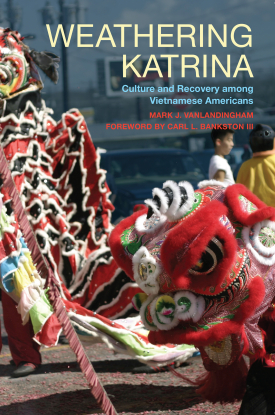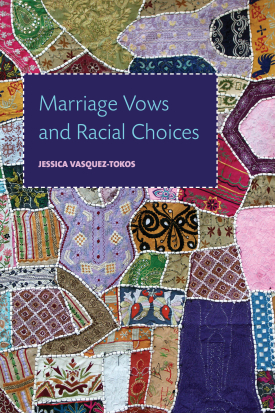
Weathering Katrina
About This Book
“Weathering Katrina is a very thoughtful and elegantly executed monograph by a master of the craft. It is social science at its best.”
— Kai Erikson, William R. Kenan, Jr. Professor Emeritus of Sociology and American Studies, Yale University
“Mark VanLandingham’s book, Weathering Katrina, tells a fascinating story of how the Vietnamese community in New Orleans East survived a major natural disaster and thrived afterward. It makes a significant contribution to the literature on disasters, community resilience, and ethnic culture.”
—Min Zhou, professor of sociology and Asian American studies, University of California, Los Angeles
In 2005, Hurricane Katrina devastated New Orleans. The principal Vietnamese-American enclave was a remote, low-income area that flooded badly. Many residents arrived decades earlier as refugees from the Vietnam War and were marginally fluent in English. Yet, despite these poor odds of success, the Vietnamese made a surprisingly strong comeback in the wake of the flood. In Weathering Katrina, public health scholar Mark VanLandingham analyzes their path to recovery, and examines the extent to which culture helped them cope during this crisis.
Contrasting his longitudinal survey data and qualitative interviews of Vietnamese residents with the work of other research teams, VanLandingham finds that on the principal measures of disaster recovery—housing stability, economic stability, health, and social adaptation—the Vietnamese community fared better than other communities. By Katrina’s one-year anniversary, almost 90 percent of the Vietnamese had returned to their neighborhood, higher than the rate of return for either blacks or whites. They also showed much lower rates of post-traumatic stress disorder than other groups. And by the second year after the flood, the employment rate for the Vietnamese had returned to its pre-Katrina level.
While some commentators initially attributed this resilience to fairly simple explanations such as strong leadership or to a set of vague cultural strengths characteristic of the Vietnamese and other “model minorities”, VanLandingham shows that in fact it was a broad set of factors that fostered their rapid recovery. Many of these factors had little to do with culture. First, these immigrants were highly selected—those who settled in New Orleans enjoyed higher human capital than those who stayed in Vietnam. Also, as a small, tightly knit community, the New Orleans Vietnamese could efficiently pass on information about job leads, business prospects, and other opportunities to one another. Finally, they had access to a number of special programs that were intended to facilitate recovery among immigrants, and enjoyed a positive social image both in New Orleans and across the U.S., which motivated many people and charities to offer the community additional resources. But culture—which VanLandingham is careful to define and delimit—was important, too. A shared history of overcoming previous challenges—and a powerful set of narratives that describe these successes; a shared set of perspectives or frames for interpreting events; and a shared sense of symbolic boundaries that distinguish them from broader society are important elements of culture that provided the Vietnamese with some strong advantages in the post-Katrina environment.
By carefully defining and disentangling the elements that enabled the swift recovery of the Vietnamese in New Orleans, Weathering Katrina enriches our understanding of this understudied immigrant community and of why some groups fare better than others after a major catastrophe like Katrina.
MARK J. VANLANDINGHAM is the Thomas C. Keller Professor at the Tulane University School of Public Health and Tropical Medicine.
RSF Journal
View Book Series
Sign Up For Our Mailing List
Apply For Funding

Marriage Vows and Racial Choices
About This Book
“If marriage patterns indicate the durability of the color line, Marriage Vows and Racial Choices is a rich account of how the color line shapes the experience of marriage. With lucid prose, Jessica Vasquez-Tokos goes inside the lives of Latina wives and Latino husbands to show how race colors whom they marry, how they stay married, and how they raise children. Demography is destiny, and Marriage Vows and Racial Choices is a must read for anyone who hopes to understand how that destiny is unfolding.”
—Tomás R. Jiménez, associate professor of sociology, Stanford University
“Jessica Vasquez-Tokos’s key contribution in this important new book is to open a black box inside theories of assimilation by illuminating how people actually make their marriage choices. Marriage Vows and Racial Choices details how race and ethnicity, generation, and gender ideologies and images about them play into people’s decisions on whom to marry. A strong empirical scientist, she follows her data to unanticipated places, deepening our understanding of immigration and contemporary America and reframing the debate.”
—Robert C. Smith, professor of sociology, immigration studies, and public affairs, Austin W. Marxe School of Public and International Affairs, Baruch College and CUNY Graduate Center
Choosing whom to marry involves more than emotion, as racial politics, cultural mores, and local demographics all shape romantic choices. In Marriage Vows and Racial Choices, sociologist Jessica Vasquez-Tokos explores the decisions of Latinos who marry either within or outside of their racial and ethnic groups. Drawing from in-depth interviews with nearly fifty couples, she examines their marital choices and how these unions influence their identities as Americans.
Vasquez-Tokos finds that their experiences in childhood, adolescence, and young adulthood shape their perceptions of race, which in turn influence their romantic expectations. Most Latinos marry other Latinos, but those who intermarry tend to marry whites. She finds that some Latina women who had domineering fathers assumed that most Latino men shared this trait and gravitated toward white men who differed from their fathers. Other Latina respondents who married white men fused ideas of race and class and perceived whites as higher status and considered themselves to be “marrying up.” Latinos who married non-Latino minorities—African Americans, Asian Americans, and Native Americans—often sought out non-white partners because they shared similar experiences of racial marginalization. Latinos who married Latinos of a different national origin expressed a desire for shared cultural commonalities with their partners, but—like those who married whites—often associated their own national-origin groups with oppressive gender roles.
Vasquez-Tokos also investigates how racial and cultural identities are maintained or altered for the respondents’ children. Within Latino-white marriages, biculturalism—in contrast with Latinos adopting a white “American” identity—is likely to emerge. For instance, white women who married Latino men often embraced aspects of Latino culture and passed it along to their children. Yet, for these children, upholding Latino cultural ties depended on their proximity to other Latinos, particularly extended family members. Both location and family relationships shape how parents and children from interracial families understand themselves culturally.
As interracial marriages become more common, Marriage Vows and Racial Choices shows how race, gender, and class influence our marital choices and personal lives.
JESSICA VASQUEZ-TOKOS is associate professor of sociology at the University of Oregon.
RSF Journal
View Book Series
Sign Up For Our Mailing List
Apply For Funding
Compared to the overall foreign-born population and to the native-born, Asian immigrants generally have higher levels of educational attainment and higher household incomes. They also make up the largest share of post-2009 immigrants—36 percent of these arrivals are Asian, compared to 31 percent Latino.
When studying earnings inequality, social scientists typically treat individuals as single points of observations or a weighted average over their lifetime. Such "snapshot" measures of inequality are appropriate when individuals tend to follow similar earnings trajectories and when there are minimal fluctuations in earnings over the life cycle. However, recent research suggests that intragenerational mobility has been increasing in jobs, occupations, and earnings.
Incarceration is disruptive to romantic and familial relationships and complicates relationships among reentering individuals and their pre-incarceration partners. Research suggests that cohabiting relationships formed after re-entry may be rapid and/or transactional, possibly due, in part, to the housing and employment challenges faced by released offenders. Such relationships may have characteristics associated with poor economic and overall wellbeing for partners and their children.
Numerous studies have demonstrated that the racial composition of individual schools and school districts influences where parents, especially whites, choose to enroll their children. For example, as the proportion of nonwhite students in a district increases, the likelihood that parents will enroll their children in charter or private schools, or move to a different school district, increases as well. At the same time, some parents value racial diversity in schools and cite it as a factor that attracts them to urban public schools.
- November 2018: Supplemental funding of $19,205 granted.
Asians comprise about 14% of the estimated 11 million undocumented immigrants in the United States. Moreover, from 2000 to 2013, undocumented immigration from Asia increased by 202%, while undocumented immigration from Mexico increased by 29%.
Pagination
- Previous page
- Page 36
- Next page
